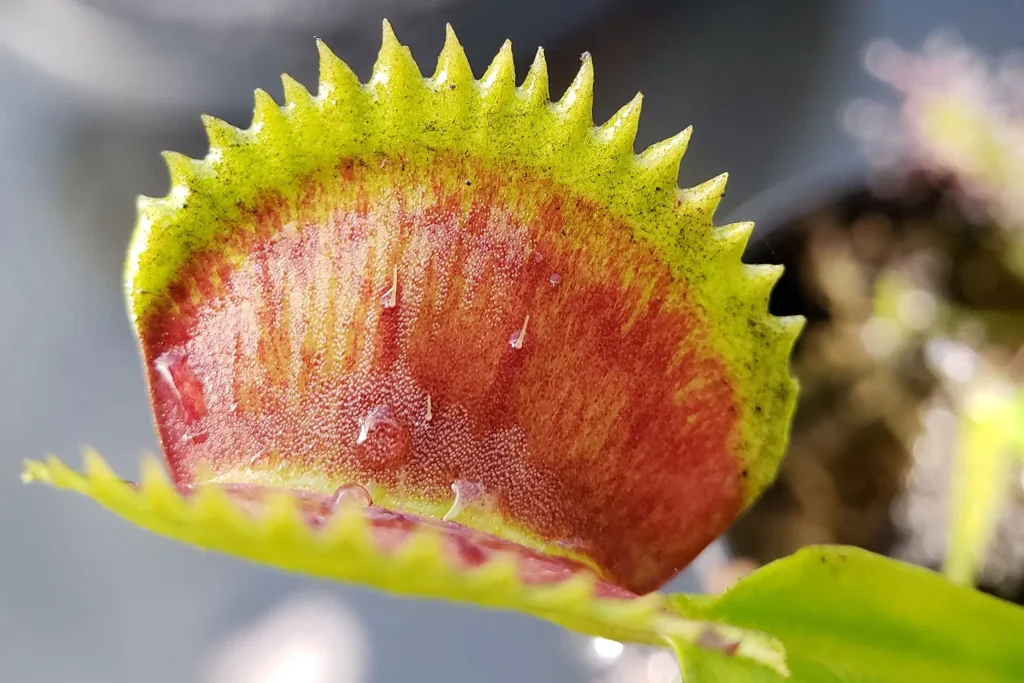
Have you heard of the plant that “eats insects”? Known for its exotic appearance and impressive trapping mechanism, the Dionaea muscipula, or Venus flytrap, is one of the most fascinating carnivorous plants in the world. Its intriguing look, combined with its ability to move quickly to capture prey, sparks curiosity in both beginners and seasoned collectors.
In this comprehensive guide, you will learn how to grow Dionaea muscipula at home, respecting its natural requirements, and discover the main mistakes to avoid. We will also take a deeper look at how the traps work, the importance of the dormancy cycle, and how to keep your plant healthy for many years.
What is Dionaea muscipula?
Dionaea muscipula is a perennial carnivorous plant, native to the wetlands of North and South Carolina in the United States. It belongs to the Droseraceae family and is the only species in the Dionaea genus. It is commonly known as the Venus flytrap.
The native environment of this plant is characterized by acidic, humid, and nutrient-poor soils—especially lacking in nitrogen. To compensate for this deficiency, Dionaea has developed a specialized insect-catching mechanism, absorbing essential nutrients from prey digestion.
How does the Dionaea trap work?
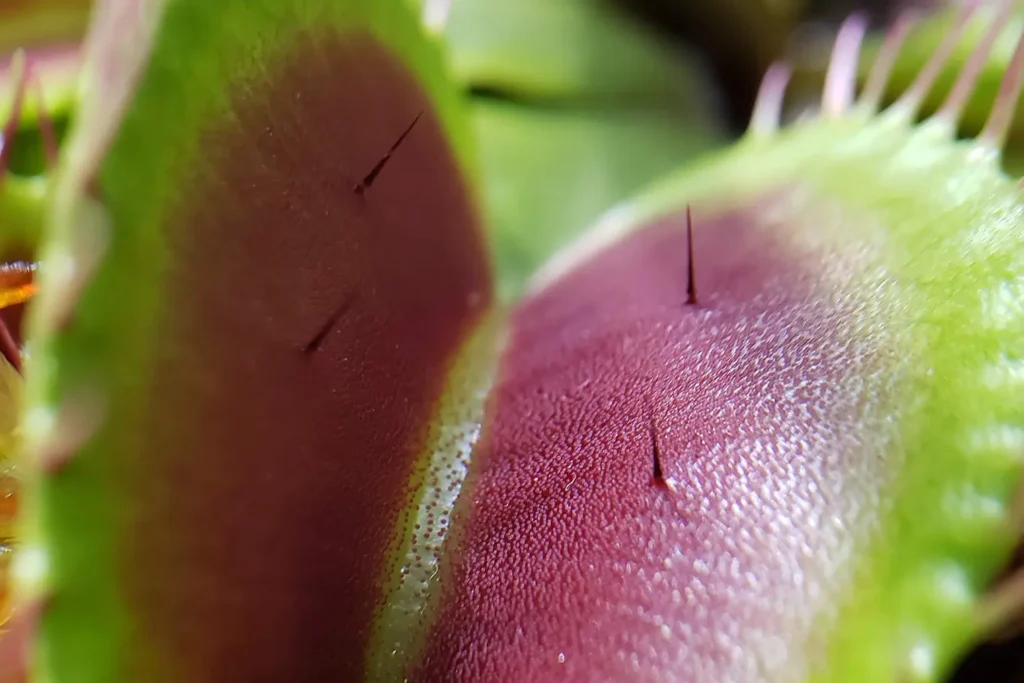
One of the most remarkable features of Dionaea is its leaf trap, formed by two “trap lobes” that close like jaws. Inside these laminas are sensory trichomes, which act as triggers. When an insect touches two of these trichomes in sequence within 20 seconds, the trap quickly closes, trapping the prey.
This quick response ability makes Dionaea one of the rare plants that actively move in response to touch. This process occurs through changes in cell turgidity, which causes the leaf to close suddenly.
The trap then secretes digestive enzymes to dissolve the insect’s soft parts. The nutrients are absorbed by the plant, and what remains (the exoskeleton) is expelled when the trap reopens.
Why does Dionaea feed on insects?
Unlike common plants, which take all nutrients from the soil, Dionaea evolved in a habitat where the soil is extremely poor in nitrogen and phosphorus. Insect feeding is an evolutionary adaptation that allows the plant to supply these vital needs for its growth.
These nutrients obtained from digesting prey are mainly used for producing new leaves and flowers, and for maintaining an active metabolism during growth.
How to Grow Dionaea muscipula at Home
Growing Dionaea muscipula at home requires attention to some specific details. Below, we explain the main points to keep your plant healthy.
1. Proper Lighting
Dionaea needs 4 to 6 hours of direct sunlight per day. If you don’t have access to sufficient sunlight, you can use full-spectrum grow lights to ensure the plant photosynthesizes efficiently.
Tip: a plant with overly green leaves may be receiving insufficient light. The intense red coloration in the center of the traps indicates good sun exposure.
2. Water Type
Dionaea muscipula is extremely sensitive to mineral salts, chlorine, and other impurities present in tap water. Therefore, the most recommended method is to water it always with distilled water, rainwater, or water purified by reverse osmosis.
If none of these options are available, it is possible to use, occasionally, high-quality filtered water — but in moderation, to prevent the build-up of residues in the substrate.
The substrate must be kept constantly moist, but never waterlogged. The safest method is using a tray with water under the pot, allowing the plant to absorb moisture through capillarity. To prevent mosquito proliferation, a helpful tip is to add a thin layer of clean sand over the water in the tray.
If the environment is prone to infestations, it is advisable to use sealed self-watering pots or trays with a lid and holes, creating a humid microenvironment without direct access to insects.
3. Ideal Growing Substrate
The Dionaea cannot be grown in regular potting soil. The substrate needs to be nutrient-poor and highly draining. Use:
- 50% sphagnum peat moss (without additives)
- 50% perlite or silica sand
Never add fertilizers or fertilizing compounds, as this will cause overfeeding and root burn.
4. Vase and Drainage
Use clear or white plastic pots, as they reflect heat and prevent root overheating. Avoid clay pots, as they absorb salts and alter the soil’s pH.
Make sure the pot has drainage holes to keep moisture controlled without waterlogging the soil.
5. Annual Dormancy (Deepened Point)
A Dionaea muscipula undergoes a winter dormancy period, usually between May and August (in the Southern Hemisphere). This period is essential for the plant’s long-term health. During this phase:
- Growth slows down or stops completely
- Some leaves die off
- The plant appears “sick,” but it’s just resting
It is essential to respect this cycle. Reduce exposure to light, decrease watering, and keep the plant in an environment with temperature between 5°C and 15°C. This phase lasts about 3 months.
If the Dionaea does not go through dormancy, it will become weakened, producing small leaves and may die within a few years.
Advanced tip: you can simulate dormancy in the refrigerator if you live in tropical regions — but this should be done carefully with proper technique and supervision.
6. The Flowering of Dionaea muscipula: Cut or Leave?
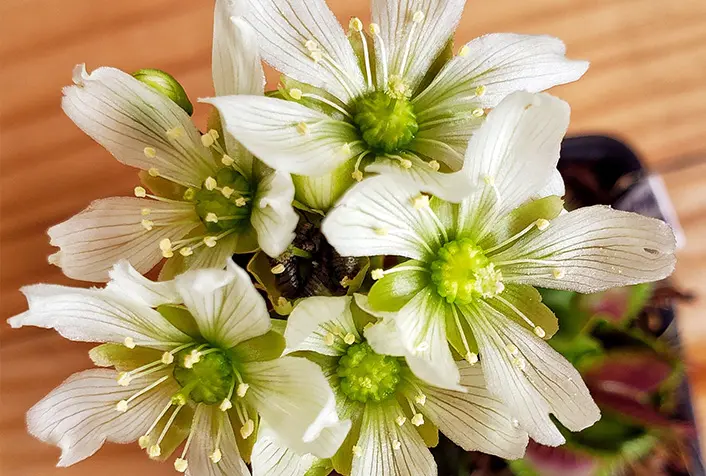
With the arrival of spring and the end of dormancy, Dionaea muscipula can surprise with the emergence of a long and slender flower stalk, different from the usual traps. And it is at this moment that many growers face a classic dilemma: should I cut or leave the flower?
The answer depends on two factors: the health of the plant and your cultivation objectives.
When should you cut the flower stalk?
Flowering requires a lot of energy from the plant. If your Dionaea is still young, weak, has few traps, or has just come out of dormancy, the best approach is to cut the flower stalk as soon as it appears — preferably when it is still no taller than 5 cm.
Benefits of cutting the flower:
- Prevents energy depletion
- Stimulates the growth of leaves and traps
- Keeps the plant more vigorous and healthy
When to let it bloom?
If your Dionaea is mature, strong, and well-adapted, allowing it to flower can be a valid choice — especially if you want to collect seeds or simply enjoy the subtle beauty of the small white flowers that bloom at the tip of the stalk.
But it’s important to keep in mind: a healthy plant can withstand flowering, but it’s common for it to reduce growth for a few weeks and even lose leaves after the process.
Extra tip: take advantage of the flowering stalk for propagation
If you choose to cut the stalk, there’s no need to discard it! As we saw earlier, you can perform stem planting of the floral stalk, a moderately effective propagation method that can produce new seedlings identical to the mother plant.
The emergence of the flower is a sign that your Dionaea is mature — but it’s not always the best time to let it bloom. Assess the condition of the plant and choose the most appropriate course of action. Cutting the flower does no harm and, in most cases, helps the plant to develop better in the long run.
Why is the floral stalk of Dionaea muscipula so long?
A flowering stalk of Dionaea muscipula can grow up to 30 centimeters in height — much taller than the leaves and traps. But this feature is no coincidence: it is an evolutionary adaptation to protect pollinators.
Since the Dionaea flowers attract insects such as bees and flies, which could also be caught by the traps, the plant developed an intelligent mechanism: elevates its flowers well above the capture area. This way, it prevents insects that assist in reproduction from being accidentally digested.
It’s a brilliant strategy of nature: by separating its feeding and reproductive functions, the Dionaea ensures the survival of the species without harming its natural allies.
This spatial separation between the flowers and the traps is one of many proofs of how evolution shapes ingenious solutions — even in a carnivorous plant.
Feeding: Should I give insects to my plant?
If you cultivate your Dionaea outdoors, it will probably capture insects on its own. Otherwise, you can offer live flies, ants, or small crickets once a month.
Never feed it meat, cold cuts, fruits, or dead insects. The trap only fully closes if the insect is alive and moving, activating digestion.
Common Mistakes in Cultivation
- Watering frequently with tap water
- Using regular or fertilized soil
- Keeping it in a low-light environment
- Triggering the traps with your finger
- Ignoring the dormancy period
Avoiding these mistakes significantly increases the longevity of your Dionaea, which can live for more than 20 years!
Reproduction of Dionaea muscipula
Dionaea muscipula can reproduce in four main ways, each with its own characteristics in terms of time, technique, and success rate. The choice of method depends on the cultivator’s goal: speed, plant volume, or genetic control.
1. By crown division
This is the fastest and simplest method, ideal for those who already have a well-developed plant.
- During the dormancy period or early spring, it is possible to separate the offshoots growing around the mother plant.
- Use sterilized tools and be careful not to damage the rhizomes.
- After separation, replant each offshoot in its own pot with suitable substrate.
Advantages: fast, high success rate
Disadvantages: limited to the number of seedlings available
2. By seeds
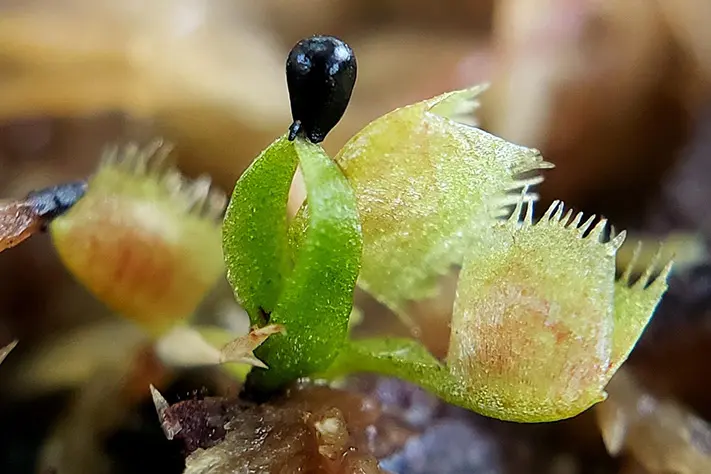
Seed reproduction is the most time-consuming method, but it is interesting for those who want to follow the plant’s complete cycle.
- Seeds should be fresh and can be sown on moist peat under high humidity and indirect light.
- Germination may take 4 to 8 weeks, and the plants usually take 2 to 3 years to reach adult size.
Advantages: ideal for crossings and genetic diversity
Disadvantages: slow growth, lower success rate
3. In vitro cultivation (laboratory)
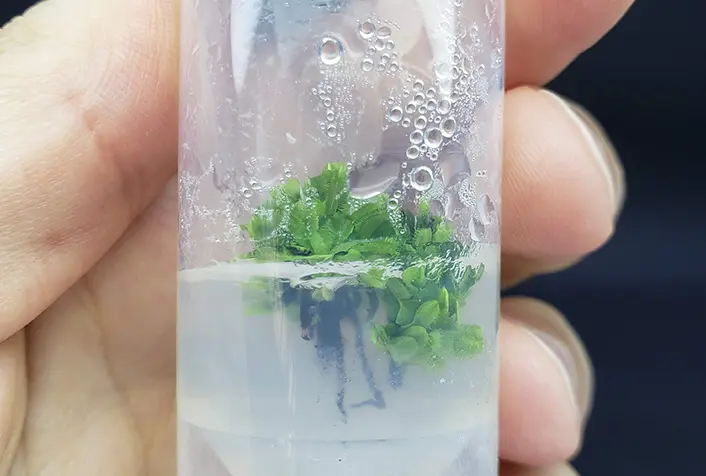
This method is used by nurseries and commercial growers.
- It consists of cloning in a sterile environment, using hormones and culture medium.
- It allows the production of thousands of genetically identical plantlets in a short time.
- It requires technical knowledge and specific equipment.
Advantages: large-scale production, standardized plants
Disadvantages: limited access, high cost for amateurs
4. Leaf Pulling
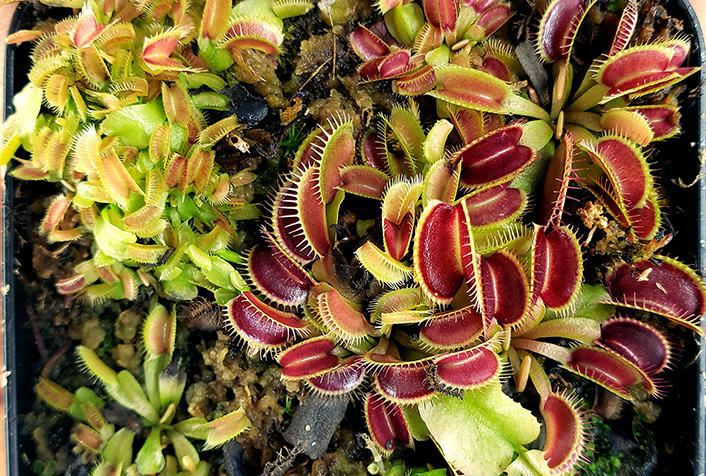
Also known as “leaf propagation”, this method is widely used by hobbyists. It consists of:
- Remove an entire leaf with part of the white rhizome (the underground base).
- Plant the leaf in moist substrate (peat + perlite) under a humid and bright environment, but without direct sunlight.
- In about 4 to 8 weeks, small plantlets may sprout from the base of the leaf.
Tip: use a homemade greenhouse or jars with transparent lids to maintain high humidity.
Advantages: accessible technique, can produce multiple seedlings
Disadvantages: moderate success rate, requires patience
5. Flower stalk cutting (floral propagation)
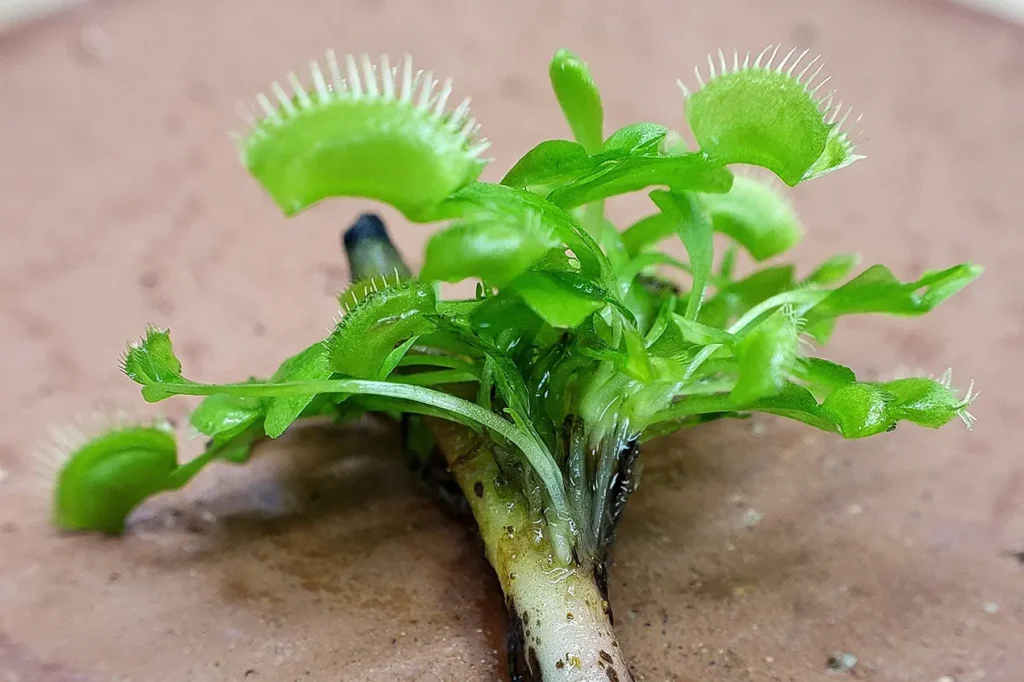
Less known, this method involves removing the young flowering stalk (still a juvenile flower) from the Dionaea and planting it in moist substrate before it fully blooms. After flowering, the chances are lower, but it’s still possible.
- The flower stalk should be cut to about 4 to 6 cm in length using a sterilized blade.
- Bury about one-third of the stalk in moist peat mixed with perlite, in a bright environment without direct sunlight.
- In 4 to 8 weeks, new shoots may emerge from the base of the flower stem.
This method avoids the energy expenditure of flowering and can generate cloned seedlings of the mother plant, with less effort than cultivating from seeds.
Which method is the best?
| Method | Time to Adult Plant | Difficulty | Ideal for… |
|---|---|---|---|
| Clump division | 3 to 6 months | Easy | Beginner growers |
| Seeds | 2 to 3 years | Moderate | Hybrids, genetic diversity |
| In vitro | 2 to 4 months | High | Commercial production |
| Leaf pulling | 3 to 6 months | Moderate | Hobbyists and collectors |
| Flower stalk cutting | 4 to 8 months | Moderate | Avoiding blooming and cloning plants |
Conclusion on Reproduction
Regardless of the method chosen, reproducing Dionaea muscipula is a rewarding experience. Seeing a new plant emerge — whether from a seed or a simple leaf — reinforces the charm of this species and strengthens the connection between the grower and nature.
If you’re just starting out, dividing tufts or the leaf method are great first steps. If you already have more experience, it’s worth trying seed germination or even exploring in vitro cultivation with professional guidance.
Main Cultivars of Dionaea muscipula: Discover the Most Fascinating Varieties
But after all, what is a cultivar?
A typical Dionaea muscipula is the plant’s natural form, as it occurs in its original habitat in North and South Carolina (USA). It features green leaves, with traps that are red on the inside, symmetrical teeth, and balanced growth. It is the most common and hardy variety for home cultivation.
The cultivars are varieties selected or developed in laboratories or nurseries, with unique characteristics that are not common in nature. This includes unusual coloration, altered shapes, fused teeth, or exceptional sizes.
These characteristics are maintained through vegetative cloning (such as division or in vitro cultivation), ensuring that each specimen retains exactly the same qualities as the original cultivar.
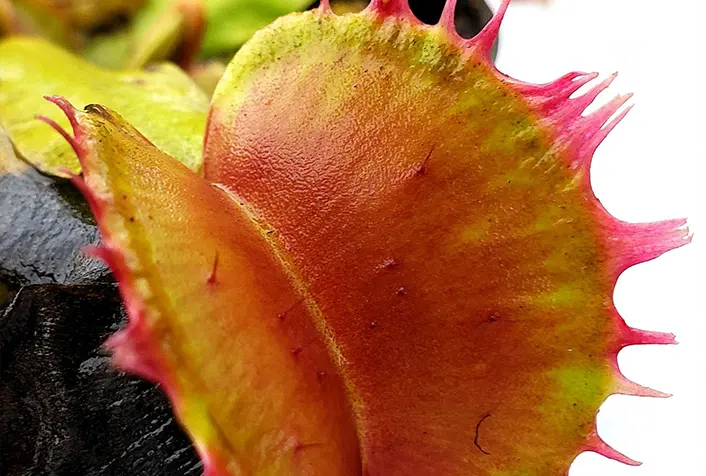
Quick Summary:
| Type | Origin | Characteristics | Propagation |
|---|---|---|---|
| Typical | Natural | Green with red traps | Seeds, clump division |
| Cultivar | Laboratory or artificial selection | Rare colors, large sizes, unusual trap shapes | Cloning or in vitro |
Popular cultivars among collectors
Below, you can check out some of the most desirable cultivars — each with its own unique features and charm:
‘Red Dragon’
It has a completely red coloration, both on the traps and the leaves. It requires a lot of sunlight to maintain the intensity of its color.
‘Green Dragon’
Similar to Red Dragon, but with completely green coloration. Perfect for those who prefer a more subtle and natural aesthetic. [end section]
‘B52’
Famous for producing giant traps, among the largest ever recorded in the species. Vigorous growth and excellent adaptation, even for beginners.
‘Dracula’
Displays darkened and short teeth, with a gloomy and exotic appearance. Ideal for themed collections or environments with a dark aesthetic.
‘Fused Tooth’
Unique appearance with fused or partially joined teeth, forming wavy edges on the traps. Highly sought after by collectors.
‘Whale’
Robusta, with broad leaves and wide traps reminiscent of a whale’s mouth. It is one of the most interesting cultivars in shape and symmetry.
Can I create my own cultivar?
In theory, yes! Starting from seed cultivation, spontaneous mutations or novel genetic combinations may arise. If the new plant displays stable and unique characteristics, it can be officially registered as a cultivar.
Practical Examples of Stable Characteristics
- A Dionaea cultivar ‘B52’ will always produce large traps.
- The ‘Red Dragon’ will maintain its deep red coloration when properly propagated.
- A ‘Fused Tooth’ will consistently show fused or merged teeth on its traps.
What Is Not Considered Stable
Temporary changes due to environmental stress.
Color that changes with light or temperature (e.g., green plants that only turn red under intense sunlight).
Occasional deformations caused by pests or nutrient deficiencies.
Summary:
A stable characteristic is heritable, predictable, and constant. This is what differentiates a true cultivar from a common variation. Therefore, only plants with stable characteristics can be officially registered as cultivars.
Insect Pest Control in Dionaea muscipula
Although Dionaea muscipula captures insects, it can still suffer from pests, especially indoors or in poorly ventilated environments.
The Most Common Are:
- Aphids and mealybugs: They suck the sap from young leaves and can weaken the plant.
- Mites: Common in dry climates, they cause spots and leaf deformities.
- Fungi: Often appear on dead leaves and in waterlogged substrate.
How to Prevent
- Remove dead leaves regularly.
- Maintain good airflow and adequate lighting.
- Avoid excess humidity during winter.
How to Treat
- Use water with a few drops of mild soap to gently clean affected leaves.
- In more severe cases, apply a soft biological pesticide such as neem oil — always away from the traps and in a very diluted dose.
Important: Avoid common chemical insecticides — Dionaea is very sensitive and can be easily harmed.
Fascinating Curiosities
- Charles Darwin called Dionaea “the most wonderful plant in the world.”
- Each trap closes a maximum of 5 times before dying.
- It takes around 10 days to digest one insect.
- Some ornamental varieties have deep purple or burgundy coloring.
Glossary
- Trichomes: Sensors inside the trap that detect insect movement.
- Sphagnum peat: A fibrous, acidic substrate ideal for carnivorous plants.
- Dormancy: A winter rest phase the plant requires each year.
- Capillarity: Water absorption method from the bottom of the pot.
- Photosynthesis: The process of converting light into energy.
Where to Buy Dionaea muscipula
You can find Dionaeas at:
- Stores specialized in carnivorous plants
- Botanical nurseries
- Rare plant exhibitions
It is strongly recommended to buy only from legitimate growers to avoid supporting the illegal harvesting of wild plants.
Dionaea muscipula is a native species protected by conservation laws in the U.S., its natural habitat. Illegal collection still threatens some wild populations. By purchasing from registered nurseries or responsible growers, you ensure healthy plants and help preserve biodiversity.
Care Summary Table
| Item | Recommendation |
|---|---|
| Light | 4–6 hours of direct sunlight or artificial grow light |
| Water | Distilled, deionized, or rainwater |
| Substrate | Sphagnum peat + perlite/silica |
| Feeding | Live insects, once a month (if needed) |
| Dormancy | 3-month annual cold period between 5 °C and 15 °C |
| Propagation | Division, seeds, or in vitro |
| Pot | White plastic pot with drainage |
FAQ – Frequently Asked Questions
Is Dionaea dangerous to children or pets?
No. Its traps only catch small insects.
Does it need pruning?
No. Just remove dead leaves to prevent mold.
Can I grow it in an apartment?
Yes, as long as there is direct sunlight or appropriate artificial lighting.
How many traps can a plant have?
From 4 to 12 active traps, depending on the plant’s age and health.
How long does it live?
With proper care, over 15 or even up to 20 years.
Conclusion
A Dionaea muscipula is much more than an exotic plant: it is a fascinating example of nature’s adaptation. With its intelligent trapping mechanism and striking appearance, it is an excellent choice for those seeking something out of the ordinary in plant cultivation.
With the care described in this article, you can successfully grow your Dionaea at home, providing it with the necessary environment to grow, bloom, and even reproduce.
Have you ever cultivated a Dionaea muscipula? Share your experience in the comments!
